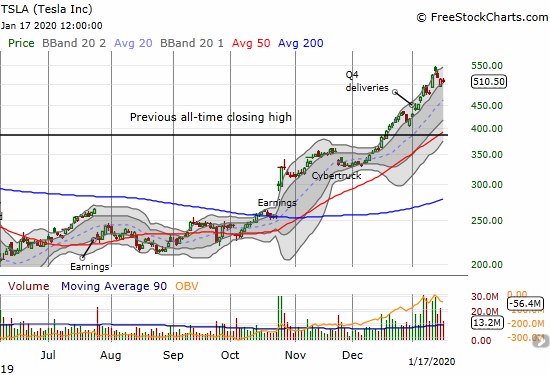Tesla (TSLA) has been on a tear.
Analyst Expectations
Analysts have stumbled over themselves to hike price targets: Canaccord Genuity from $375 to $515, Piper Sandler from $423 to $553, Oppenheimer from $385 to $612, and Jeffries from $400 to $600. At least three analysts have staunchly defended their bearishness: Credit Suisse reluctantly hiked its price target from $200 to $340, Morgan Stanley grudgingly went from $250 to $360 (along with a downgrade), and Cowen even more reluctantly went from $190 to $210. Earnings on January 29th will further test the mettle of prognosticators. With widely divergent expectations for TSLA, I expect another big post-earnings move, up or down. Surprisingly, the options market does not (yet?) agree with pricing in the kind of monster move TSLA experienced for October earnings. At that time, the stock gained 17.7% post-earnings which confirmed a breakout above the stock’s 200-day moving average (DMA) and helped fuel the momentum that continues today.

Source: FreeStockCharts
Options Pricing
One approximate way to calculate the market’s near-term price expectations is to use the value of a straddle with a strike at the current price of the stock. A straddle is an options position of calls and puts in the same quantity of each and each with the same strike price. Presumably, market makers selling calls and puts price these options such that their odds are very high for making a profit; thus the convention for using the straddle as an approximate measure for price expectations. When a stock launches into a strong trend, these pricing mechanisms of course break down.
TSLA closed last week at $510.50. The price of weekly call options expiring January 31st, two days after TSLA reports, was $26.50/$27.10. The price of weekly put options with the same expiration was $25.90/$26.60. The midpoint of the bid/ask spread is $26.80 + $26.25 = $53.05. So at the close Friday, the market expected TSLA to stay within a range of $457 to $563, or about +/-10%, by January 29th.
For comparison, here are the weekly price changes for TSLA starting with the first full post-earnings week. The dates are the Fridays of the given week.
- Nov 1: -4.5%
- Nov 8: +7.6%
- Nov 15: +4.4%
- Nov 22: -5.4%
- Nov 29: -0.9%
- Dec 06: +1.8%
- Dec 13: +6.7%
- Dec 20: +13.2%
- Dec 27: +6.1%
- Jan 03: +2.9%
- Jan 10: +7.9% (max +12.6%)
- Jan 17: +6.8% (max +14.5%)
I included the maximum weekly gain in the last two weeks (measured from the intraday high of the week) to show the recent acceleration in TSLA’s price action. The options pricing indicates that the market doubts this acceleration is sustainable in the short-term. I consider this pricing an opportunity for (bullish) speculation at a much cheaper price than I expected.
The Trade
So if the market thinks TSLA’s maximum price on January 29th will be $563, then I want to speculate on a call spread around that target. Interestingly, the Jan 29th $560 call costs about $10 while the $570 costs about $8.00. If TSLA hits the $563 target, then this spread will be worth about $3.00, a 50% increase. If the market is under-pricing upside risk, then the potential is of course much higher. I also suspect TSLA could run-up to $550-560 ahead of earnings and deliver pre-earnings profits.
On the downside, the $460 put costs $9.00 and the $450 put costs about $5.90. If TSLA hits the market’s maximum downside price, then the spread comes out just about even. This kind of downside skew in pricing making puts more expensive than calls is common in options pricing. It also shows how the wider opportunity lies to the upside.
Note if TSLA moves up ahead of my ability to place the pre-earnings trade, I may just stay content with my current positioning. If TSLA moves down ahead of my buying opportunity, then I will slide my strikes downward accordingly.
Strong run-ups ahead of earnings can be dangerous because they send expectations to high levels that a company will struggle to match. TSLA is now up an incredible 70.3% since its first post-earnings close which implies sky high expectations going into January earnings. Thus, my speculative trade is not an attempt to predict what will happen, but instead an attempt to configure a trade that profits if the upside optimism in TSLA continues apace. (Note well that this trade is made all the more speculative by a stock market which is treading on the threshold of overbought conditions).
Currently, I hold a hedged position skewed to the upside with shares short married to calls and a call spread. These calls are the latest configurations in what has been an on-going rotation of preserving profits as TSLA has persistently marched higher.
Epilogue
Speaking of high expectations, a friend sent me an article from Wheeljoint.com that caught me off-guard. Wheeljoint.com produced data demonstrating how Tesla sales in the luxury sedan market are likely and significantly cannibalizing luxury sedan sales across the market. See “Tesla Model 3 is wreaking havoc in ICE luxury sedan market.”
Be careful out there!
Full disclosure: long TSLA calls and call spread and short shares
